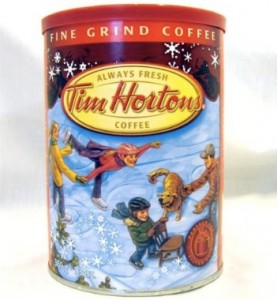“Joy in the task of coffee” – Anais Nin
Coffee brews while I eat my cereal and get the kids dressed for school.

 Brown Sugar – 3g portion/11.3 Calories Consumed
Brown Sugar – 3g portion/11.3 Calories Consumed
Coffee – 178g portion/1.8 Calories Consumed
The first thing I notice about the coffee is that only 1.8 Calories get consumed in a serving. This must mean that the vast majority of engery that went into producing the beans is contained in the used grounds.
 Fortunately, those grounds do wonders in our garden. Unfortunately, most people probably throw their used grounds in the garbage. In that case, coffee must represent one of the most energy wasteful products in the world.
Fortunately, those grounds do wonders in our garden. Unfortunately, most people probably throw their used grounds in the garbage. In that case, coffee must represent one of the most energy wasteful products in the world.
I looked into Tim Hortons policies on coffee bean purchasing and was saddened to find that they do not reveal much about their practices. They only vaguely state that they do business with many different growers and participate in sustainability programs. This leads me to fear the worst about their capitalistic endeavours.
Coffee, I’ve learned, is not an energy efficient process in any regard. Let’s examine a generally unsustainable, commercial process. Coffee trees take 3-4 years to bear fruit and require special attention during growth (oil). Once the fruit is ready, it is harvested using cherry pickers (oil/labour). The “wet cherries” are loaded (oil) and transported (oil) to a processing area (oil) where they are softened and the fruit is removed from the bean. Then the beans are sorted and packaged (probably plastic bags [oil]). Transporting (oil) the beans from tropical plantations usually requires air freight (big oil). The plane lands and the beans are unloaded (oil) and loaded (oil) for transportation (oil) to a roasting plant. At the plant, the beans are unloaded (oil) and roasted (oil). 
Once the beans are roasted, they’re packaged (oil), loaded (oil) and shipped (oil) to my local Tim Hortons. I walked across a parking lot, over to Tim Hortons to purchase them. I noticed a ridiculous number of oil puddles.
Next up, Redpath brown sugar. I was immediately dismayed to discover that my brown sugar as actually refined white sugar with molasses added to it. The discovery defeated my whole intention of using brown sugar to avoid the refinement process. Next time, I will investigate more thoroughly!
Let’s have a look at exactly how the sugar got to my kitchen.
Sugar cane is grown in tropical and sub-tropical regions. The plant is harvested (oil/labour), loaded (oil) and shipped (big oil) overseas to companies like Redpath.
Now, Redpath makes two interesting claims. One, “Redpath Sugar Ltd. has been awarded the Canadian Industry Program for Energy Conservation (CIPEC) Leadership Award for 2009.” And two, “We use ocean going ships to transport raw sugar to our plant, the greenest way possible.”
At the factory, it is milled (oil) and the juices are extracted. Next, the juice is boiled so that water can evaporate out. This steam is said to enhance the energy efficiency of the factory. The resulting liquid is spun and dried (oil) and stored.
“In the cane sugar factory the bagasse (cane fiber) fuel is renewable and the gases it produces, essentially CO2, are more than used up by the new cane growing. Add to that the factory use of low grade heat [a system called co-generation] and one can see that a well run cane sugar estate is environmentally friendly.” – www.sucrose.com
At Redpath factories, the raw sugar is refined. The processes involved are softening, carbonation, decolorization and boiling. Since the finer-gas claim can’t be used here, I will speculate the following… oil, oil, oil and oil. The product is then packaged. My sugar came in a plastic bag (oil)…. I should have known! It is then loaded (oil) and transported (oil) to the grocery store. I walk to the grocery store.

Hi! Can i ask where you found your information about Tim Horton’s coffee, because i’m doing a research on it’s coffee and i can’t find those information anywhere? Thanks 🙂
hello. I got my info from the Tim Horton’s Sustainability Summary Report. However, like my post says, I didn’t use any specific information from the report. Instead, I examined the process of coffee bean cultivation and processing from a more general website. Hope that helps.